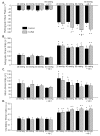Brachial artery flow-mediated dilation following exercise with augmented oscillatory and retrograde shear rate
- PMID: 22883166
- PMCID: PMC3492050
- DOI: 10.1186/1476-7120-10-34
Brachial artery flow-mediated dilation following exercise with augmented oscillatory and retrograde shear rate
Abstract
Background: Acute doses of elevated retrograde shear rate (SR) appear to be detrimental to endothelial function in resting humans. However, retrograde shear increases during moderate intensity exercise which also enhances post-exercise endothelial function. Since SR patterns differ with the modality of exercise, it is important to determine if augmented retrograde SR during exercise influences post-exercise endothelial function. This study tested the hypothesis that (1) increased doses of retrograde SR in the brachial artery during lower body supine cycle ergometer exercise would attenuate post-exercise flow-mediated dilation (FMD) in a dose-dependent manner, and (2) antioxidant vitamin C supplementation would prevent the attenuated post-exercise FMD response.
Methods: Twelve men participated in four randomized exercise sessions (90 W for 20 minutes) on separate days. During three of the sessions, one arm was subjected to increased oscillatory and retrograde SR using three different forearm cuff pressures (20, 40, 60 mmHg) (contralateral arm served as the control) and subjects ingested placebo capsules prior to exercise. A fourth session with 60 mmHg cuff pressure was performed with 1 g of vitamin C ingested prior to the session.
Results: Post-exercise FMD following the placebo conditions were lower in the cuffed arm versus the control arm (arm main effect: P < 0.05) and without differences between cuff pressures (20 mmHg: 5.7 ± 2.2%; 40 mmHg: 4.7 ± 1.3%; 60 mmHg: 5.4 ± 2.4%) (P > 0.05). Following vitamin C treatment, post-exercise FMD in the cuffed and control arm increased from baseline (P < 0.05) but were not different (control: 7.1 ± 3.5% vs. cuffed: 6.6 ± 3.3%) (P > 0.05).
Conclusions: These results indicate that augmented oscillatory and retrograde SR in non-working limbs during lower body exercise attenuates post-exercise FMD without an evident dose-response in the range of cuff pressures evaluated. Vitamin C supplementation prevented the attenuation of FMD following exercise with augmented oscillatory and retrograde SR suggesting that oxidative stress contributes to the adverse effects of oscillatory and retrograde shear during exercise on FMD.
Figures


Similar articles
-
Vitamin C prevents the acute decline of flow-mediated dilation after altered shear rate patterns.Appl Physiol Nutr Metab. 2013 Mar;38(3):268-74. doi: 10.1139/apnm-2012-0169. Epub 2012 Nov 21. Appl Physiol Nutr Metab. 2013. PMID: 23537017 Clinical Trial.
-
Evidence of sex differences in the acute impact of oscillatory shear stress on endothelial function.J Appl Physiol (1985). 2019 Feb 1;126(2):314-321. doi: 10.1152/japplphysiol.00729.2018. Epub 2018 Nov 1. J Appl Physiol (1985). 2019. PMID: 30382805 Free PMC article.
-
Examining the acute effects of retrograde versus low mean shear rate on flow-mediated dilation.J Appl Physiol (1985). 2019 May 1;126(5):1335-1342. doi: 10.1152/japplphysiol.01065.2018. Epub 2019 Mar 7. J Appl Physiol (1985). 2019. PMID: 30844335 Free PMC article.
-
Mechanistic, participant, and movement-related factors that contribute to low-flow-mediated constriction.Eur J Appl Physiol. 2023 Dec;123(12):2687-2697. doi: 10.1007/s00421-023-05332-y. Epub 2023 Oct 7. Eur J Appl Physiol. 2023. PMID: 37804365 Review.
-
Impact of prolonged sitting interruption strategies on shear rate, flow-mediated dilation and blood flow in adults: A systematic review and meta-analysis of randomized cross-over trials.J Sports Sci. 2022 Jul;40(14):1558-1567. doi: 10.1080/02640414.2022.2091347. Epub 2022 Jun 22. J Sports Sci. 2022. PMID: 35731706
Cited by
-
The effect of α1 -adrenergic blockade on post-exercise brachial artery flow-mediated dilatation at sea level and high altitude.J Physiol. 2017 Mar 1;595(5):1671-1686. doi: 10.1113/JP273183. Epub 2016 Dec 29. J Physiol. 2017. PMID: 28032333 Free PMC article. Clinical Trial.
-
Low-to-Moderate-Intensity Resistance Exercise Is More Effective than High-Intensity at Improving Endothelial Function in Adults: A Systematic Review and Meta-Analysis.Int J Environ Res Public Health. 2021 Jun 22;18(13):6723. doi: 10.3390/ijerph18136723. Int J Environ Res Public Health. 2021. PMID: 34206463 Free PMC article.
-
Lower limb conduit artery endothelial responses to acute upper limb exercise in spinal cord injured and able-bodied men.Physiol Rep. 2015 Apr;3(4):e12367. doi: 10.14814/phy2.12367. Physiol Rep. 2015. PMID: 25847920 Free PMC article.
-
Individuals with controlled hypertension show endothelial integrity following a bout of moderate-intensity exercise: randomized clinical trial.Sci Rep. 2021 Apr 20;11(1):8528. doi: 10.1038/s41598-021-87990-6. Sci Rep. 2021. PMID: 33879820 Free PMC article. Clinical Trial.
-
Differences in brachial and femoral artery responses to prolonged sitting.Cardiovasc Ultrasound. 2014 Dec 15;12:50. doi: 10.1186/1476-7120-12-50. Cardiovasc Ultrasound. 2014. PMID: 25512175 Free PMC article.
References
-
- Green DJ. Exercise Training as Vascular Medicine: Direct Impacts on the Vasculature in Humans. Exerc Sport Sci Rev. 2009;37(4):196–202. - PubMed
-
- Rush JWE, Turk JR, Laughlin MH. Exercise training regulates SOD-1 and oxidative stress in porcine aortic endothelium. Am J Physiol Heart Circ Physiol. 2003;284(4):H1378–H1387. - PubMed
-
- Hambrecht R, Adams V, Erbs S, Linke A, Krankel N, Shu Y, Baither Y, Gielen S, Thiele H, Gummert J. Regular physical activity improves endothelial function in patients with coronary artery disease by increasing phosphorylation of endothelial nitric oxide synthase. Circulation. 2003;107(25):3152–3158. - PubMed
Publication types
MeSH terms
LinkOut - more resources
Full Text Sources
Medical
Research Materials

